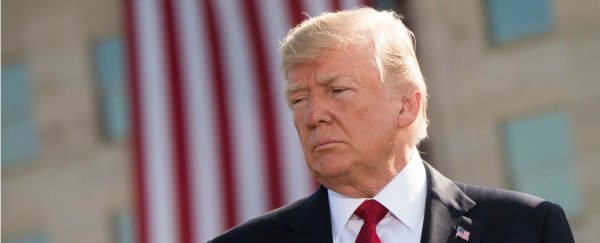President Trump can add another tick in the records column: This week, he doubled the length of time that any modern president has gone without a science adviser.
George W. Bush set the previous record for the longest science adviser vacancy at nine months and four days. Bush, four months into his presidency, nominated physicist John H. Marburger III to direct the Office of Science and Technology Policy. The Senate confirmed Marburger on Oct. 23, 2001.
Barack Obama selected his science adviser before assuming office, as did John F. Kennedy, Richard Nixon and Bill Clinton. Every administration since Eisenhower named a science adviser by the first October of the presidency, according to a Washington Post analysis.
Except for Trump — who has yet to make a nomination, let alone begin the congressional confirmation process.
"There are many things about the Trump presidency that are historic, and the disregard for science will be seen as high on the list," said Kumar Garg, a fellow at the nonprofit organization Society for Science and the Public who was a member of the Office of Science and Technology Policy during the Obama administration.
"If you had asked somebody at the start of the administration if we would be approaching this sort of marker," Garg said, "they would have been shocked."
Congress established the Office of Science and Technology Policy, or OSTP, in 1976, as a way to channel scientific analysis and advice to the president. Most presidents also gave OSTP directors the title of assistant to the president for science and technology. That appointment allowed advisers to directly and confidentially communicate with the president.
In the past, science advisers guided presidents during disease outbreaks, natural disasters, biological weapons attacks and other national crises. The advisers also led the OSTP's review of federal research, and collaborated with the Office of Management and Budget to develop a research budget.
Science advisers to the president typically hold advanced degrees and have leadership experience in research institutions. The job requires comprehension of dozens of branches of science and fields as varied as national security, climate and artificial intelligence. The highest-ranking member of OSTP is deputy assistant Michael Kratsios, a 31-year-old Princeton graduate who majored in politics, as a profile notes.
On Monday, Sen. Christopher A. Coons (D-Del.) sent a letter to Trump urging the president to select a science adviser. "Currently, nine out of ten key OSTP staff positions remain vacant," he said.
Nothing less than U.S. scientific leadership is at risk, Coons warned. "I remain quite concerned that, when it comes to science, America is falling behind its major competitors," he said, citing a skyrocketing trend in Chinese research and development.
This was not the first letter lawmakers have sent to Trump about vacancies at the OSTP. In November, Sen. Maggie Hassan (D-N.H.) and six other Democrats issued a similar letter to the president, urging Trump to make a nomination.
"In previous administrations, OSTP was central to disaster-mitigation efforts, including hurricanes — but when Hurricanes Irma, Harvey and Maria struck the United States, OSTP lacked key leaders," the senators said.
"Scientific and technical input would also have contributed to decisions around climate change, the Iran nuclear deal and North Korea's nuclear program — areas where key decisions have been made over the past nine months in absence of a science adviser and other officials."
There is also an unusually large number of empty desks in the OSTP's wing of the Eisenhower Executive Office Building, the senators noted in the November letter. "Beyond its leadership, OSTP continues to operate well below full capacity: recent reports indicate OSTP has fewer than 50 staff, well below its peak of 130 or more in the past."
The OSTP did not respond to a request for comment from The Post asking for clarification about the number of staff members.
In the absence of an official nomination, rumors and suggestions have filled the void. Garg said he has received about a phone call a month from a reporter, asking for his opinion on a possible nominee.
When Bill Gates brought up the vacancy in a meeting with Trump, Trump reportedly offered Gates the job on the spot. (Gates declined, telling the president it would not be a "good use of my time," the Microsoft founder recalled to Stat in April.)
A Freedom of Information Act request by Science magazine revealed in February that Kratsios has met with at least three candidates for the position, but their names were redacted. The Post reported in March that University of Oklahoma meteorology professor Kelvin Droegemeier may get the nomination.
Given Trump's track record with science, journalist Brian Palmer argued at Slate that the White House was better off without a science adviser. "No sane, credible scientist worth having in the position would take it," Palmer said. Just look at what happened to Marburger, Bush's science adviser, he suggested.
Marburger, a Democrat, had publicly criticized Bush for his delay in picking a science adviser, so when Bush asked Marburger to take the job, the physicist accepted.
But Bush did not give Marburger the assistant to the president appointment, which hamstrung the adviser's influence. Instead, Bush called on Marburger to defend the White House's approach to climate change and stem cell research.
When Marburger died in 2011, The Post wrote that he was "singled out as the administration's whipping boy" by critical scientists. (After Marburger took the job, Harvard University psychologist Howard Gardner told NPR that the physicist "basically has become a prostitute.")
Whoever accepts Trump's nomination, Palmer said, risks facing the same ridicule.
But former OSTP officials maintained that a scientist with a line to the president's ear was better than nothing.
"The science community should want the position filled," Garg said, "and should want the position filled with someone who is qualified and capable."
2018 © The Washington Post
This article was originally published by The Washington Post.
